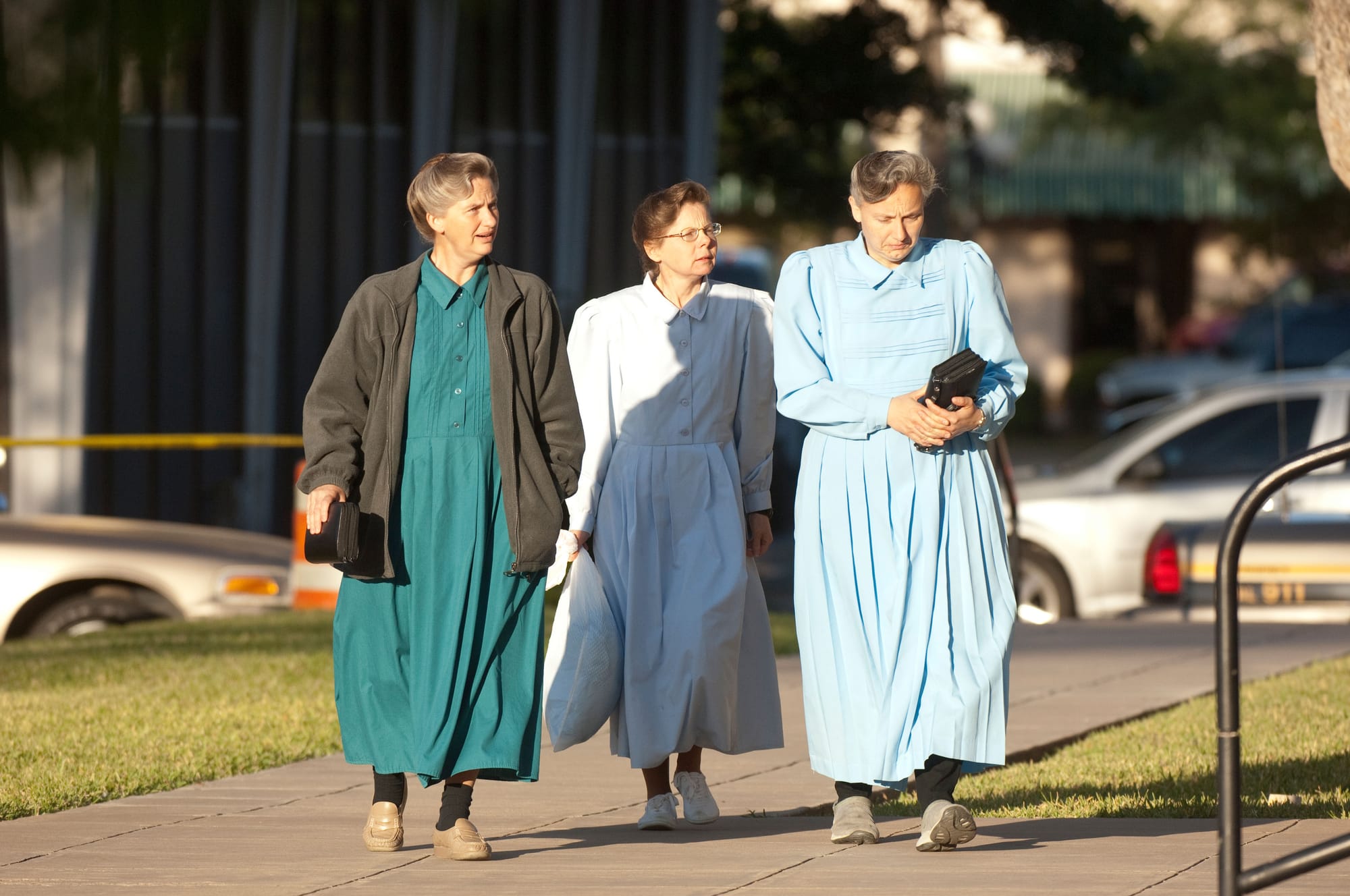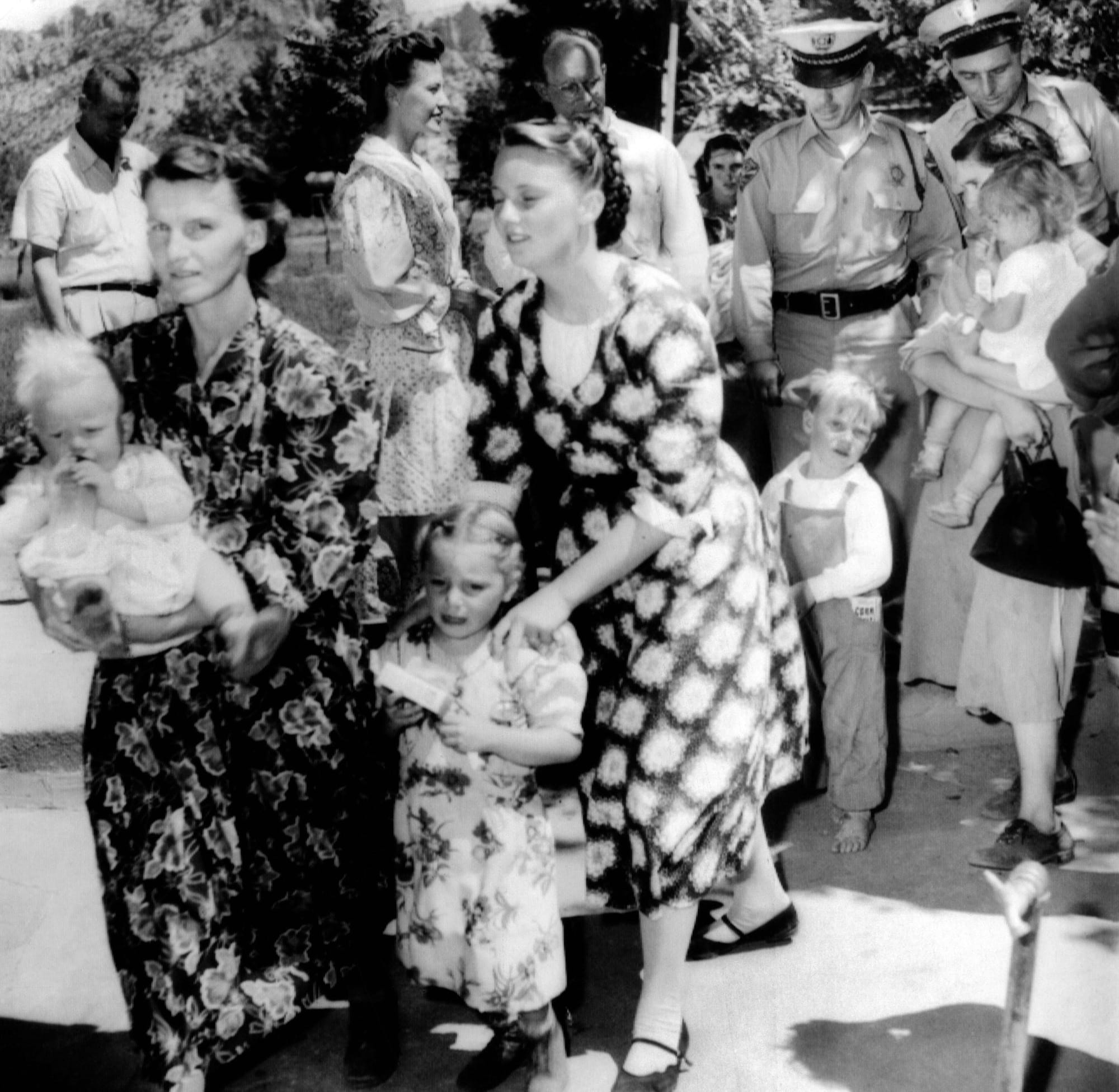Politics
Why Not Polygamy? Examining the Case for Legalisation
Polygamy is a criminal offense throughout the Western world. Would making it legal be progress?

In the 19th century, Mormon polygamy shocked the American public, and Utah was only granted statehood on the condition that it prohibit it forever. Today, 80 percent of Americans still think it’s wrong according to a 2020 Gallup poll, but that number is trending downwards. In Canada, a 2018 Ipsos poll found that 36 percent of respondents approved of decriminalizing polygamy. Polyamory and polygamy are both gaining mainstream media respect, and are often treated as equivalent, but they aren’t. Legalization of polygamy has long been a cause aided by reality TV and TV dramas. A blog post at the Daily Kos in 2013:
Rarely does a reality TV show open your eyes to your own prejudices. Sister Wives is that rare exception. Kody Brown and his four wives are fundamental[ist] Mormons living a polygamous lifestyle. Over the past year I’ve watched the Browns marry wife #4, raise their kids, deal with police investigations, and move to Las Vegas. They’ve really changed how I thought about polygamy.
Court cases, including one brought by Kody Brown and his wives, have sought legalization. In 2020, Utah passed a law that decriminalized polygamy, but few voices have been heard wondering if Utah is meeting its obligation to “prohibit” it.
Legalization gets support not only from polygamous religious sects, but also from some scholars, lawyers, philosophers, and cultural critics representing a wide span of political, moral, and religious attitudes. Pop science lends credence to these views by describing monogamy as a bad fit for biological human nature and a potent source of personal misery. Supporters point out that men can have scores of babies by scores of women and walk away, while women can have only a small number of babies—as many with one man as with 20—and must feed and care for them.
Despite the keen interest of the commentariat, public debates about polygamy tend to be disturbingly fact-free, and driven by terminological and other confusions. “Polygamy” refers to any system of plural marriage, polyandrous or polygynous, but polyandry is so rare that for practical purposes polygamy is polygyny. For zoologists, “polygyny” means only that males of a given species mate with more than one female. But when we discuss norms, laws, and social practices, we’re talking about social polygyny. Social polygyny is a set of norms that permit men to be married to many wives at the same time, but restrict women to one husband at a time, as in fundamentalist Mormon practice.
Zoologically speaking, a species would be polygynous even if males stuck exclusively to one mate, and re-mated only upon the mate’s death. But socially speaking, this would amount to a strict form of serial monogamy, and it would have vastly different social effects from polygyny. Polygamy and polyamory get lumped together in argument, but polygamy is a form of marriage and polyamory is primarily a sexual ethic. Some polyamorists now call for legalizing polyamorous marriage. But polyamorous marriage, too, presents a different set of social and legal questions from polygyny—unless, of course, the form of polyamorous marriage sought was, or inevitably would become, a de facto form of polygyny.
In their monograph The Myth of Monogamy: Fidelity and Infidelity in Animals and People, David P. Barash and Judith Eve Lipton argue that polygyny is practiced in 85 percent of human societies, and that it is therefore the biologically “natural” way that human beings mate. Monogamy, on the other hand, is miserable and hard and has high rates of infidelity and divorce. But the most common type of human mating relationship is serial monogamy, and the way most human beings have ever lived can’t really be unnatural. In any case, what is or is not natural does not help us decide how we ought to live.
Others claim that Christianity’s historical role in rooting out polygamy indicates that monogamy is a remnant of oppressive, outdated Christian sexual morality, like Christian doctrine on divorce and homosexuality. But church opposition to polygamy wasn’t based on sexual morality. Nor would the church’s approval necessarily show that monogamy is a bad idea.
The total US polygynous population is estimated to be as high as 150,000, but hard data is in short supply. The majority are probably fundamentalist Mormons, with 20,000 to 60,000 members. But Muslim polygynists are reckoned at anywhere from 20,000 to 100,000 or more. The two largest of the many Mormon fundamentalist sects are the Fundamentalist Church of Jesus Christ of Latter-Day Saints (FLDS) and the less extreme Apostolic United Brethren (AUB), to which Kody Brown belongs. Serious abuses by the Texas FLDS group headed by Warren Jeffs led to arrests and convictions that made the news 14 years ago. Mormon fundamentalist enclaves are found in Canada, Mexico, Utah, Arizona, Texas, South Dakota, North Dakota, Minnesota, Colorado, Wyoming, Nevada, and Missouri.

Arguments offered in support of polygyny
Most of us believe that people should be free to live as they please, so long as they’re not hurting anyone else. This conviction is used to support arguments in favor of polygamy like these:
• Polygyny saves many women from being mateless and childless.
• Many would prefer to be the plural wife of a fine man rather than the single mate of an ordinary or inferior one.
• Many would welcome co-wives to share childcare and household chores and to offer supportive affection and companionship.
• Polygyny creates a larger pool of available men from which monogamous women may choose, enabling them to get better mates.
• Polygyny would reduce divorce, marital infidelity, and the number of fatherless children. A polygynous man seeking sexual variety needn’t divorce one wife to add a new one and needn’t seek extramarital affairs which might produce children he abandons.
• The men left mateless will be those least desirable as mates and fathers—poorer, weaker, badly behaved, and less educated. They won’t be too numerous because polygyny rates are generally low.
• If polygyny causes harms, mitigation of those harms, not prohibition, should be the response.

Overall, defenses of polygamy tend to be heavy on doctrinal and constitutional argument, and light on—or dismissive of—facts. However, these arguments must be considered alongside an immense body of empirical evidence. Samples of that evidence can be found here, here, and here, but I will summarize the salient conclusions about polygyny’s effects.
Effects on men
• Polygyny, even at low-sounding percentage rates, creates a shortage of unmarried women and an excess of unmarried men. In a simple society of 100 people, suppose only three out of 50 men (or six percent) are polygynous. Suppose two of them have three wives each and the third, a very rich man, has 10. That means those three men marry 32 percent of the women, leaving just 34 for the remaining 47 men. Over a quarter of the men will have no wives. Even these modest levels of polygyny are sometimes exceeded in real life. In Burkina Faso and Nigeria, 36 percent and 28 percent of households, respectively, are polygynous; in Togo 54 percent of married women are in polygynous marriages. Some United States polygynous communities have had very high rates.
• Polygyny creates intense male competition for mates. In polygynous societies, all married men are still in the marriage market because they can always marry more wives. In a monogamous society, once a man marries, he exits the competition.
• In polygynous societies, competition among men for mates motivates male control over their sisters, daughters, and wives. Sisters and daughters can be traded for a new wife or for money, goods, labor, favors, and political or military support from other men. To consolidate these deals, they need the power to force the girls and women to marry. Polygynous husbands may seek control over their wives so as to compel their labor, and also because their wives’ sexual opportunities with them are limited compared to those of monogamous women’s. Young wives, meanwhile, may prefer young men to old husbands.
• In societies where women and children are important as laborers for their husbands and fathers—as they often are in polygynous relationships in the United States—competition for wives increases, creating a larger number of unmarried males.
• Unmarried men in both polygynous and monogamous societies commit far more crimes than married men. Having a wife reduces the chance that a man will commit a crime by half. (Unmarried cohabitation doesn’t reduce crime.)
• A study in Malawi found that polygynous husbands had more extramarital affairs than monogamous husbands.
Effects on women
• Women in polygynous societies have low status and less freedom than women in monogamous societies.
• Arguments that many women favor polygyny and should be free to choose it assume that in polygynous societies women would be free to choose their husbands. They also assume that in polygynous societies women who “chose” monogamy could prevent a husband from marrying again. They assume that women’s far stronger rights, status, and freedoms in monogamous societies and traditions don’t depend upon monogamy.
• Women in polygynous societies have worse health, shorter lives, lower education, and a higher suicide rate than women in monogamy.
• Co-wives must compete with each other for love, sex, and money, and for education, inheritances, and paternal care and attention for their children. One study reports, “Co-wife conflict is ubiquitous in polygynous households. From anthropology, a review of ethnographic data from 69 non-sororal polygynous societies from around the globe reveals no case where co-wife relations could be described as harmonious...” A clear majority of monogamous households (though certainly not all) are happy or satisfied.
• Polygynous wives suffer more violence and abuse. The age gap between polygynous husbands and their younger wives often increases marital conflict.
• The shortage of women in polygyny forces men to seek younger and younger wives. Women’s average age at marriage is 10 years younger than in monogamy, they are much younger when they first give birth, and they have a wider marital age gap.
• Early marriage and child-bearing contribute heavily to poorer mental and physical health for women—more depression, nervous breakdowns, and higher mortality and shorter lives than monogamous women.

Effects on children
• Children in polygynous relationships receive much less paternal attention and care. Polygyny reduces a man’s investment of time and resources in each of his more numerous offspring. One man with several wives and a lot of children can’t give any of them the time and attention a monogamous man can give each member of his family. (So far, Kody Brown seems to have 18 children. FLDS recommends that each man takes at least three wives; its leaders sometimes have staggering numbers—for example, Canadian FLDS leader Winston Blackmore has 150 children by 27 wives.)
• Excess boys have been abandoned or forced out of some fundamentalist Mormon communities.
• Children in polygynous families suffer more abuse, neglect, and violence than those in monogamous families, and have more physical, emotional, and behavioral problems.
• Infant mortality is much higher in polygynous than in comparable monogamous societies. Within polygynous societies, children in monogamous families also have lower mortality rates than those in polygynous families. In 19th century American polygyny, the children of poor men’s monogamous marriages had significantly better survival rates than the children of rich polygynists.
• A study reports: “In Africa, diverse studies show that, relative to children from monogamous households, children from polygynous household[s] risk diminished nutritional status, poorer health outcomes, and diminished mortality. … [B]oth infant and child mortality in [highly polygynous countries] are roughly twice that of [comparable monogamous countries].”
• Conflict in polygamous households endangers children by creating higher levels of violence and constant stress. Often it will be a co-wife and not the father who abuses or murders a child. A good deal of evidence confirms that, on average, children are in far more danger in families comprised of many unrelated adult-child “dyads” (two-person pairs) and less-related child-child dyads: “Living in the same household with genetically unrelated adults is the single biggest risk factor for abuse, neglect and homicide of children. Stepmothers are 2.4 times more likely to kill their stepchildren than birth mothers, and children living with an unrelated parent are between 15 and 77 times more likely to die ‘accidentally.’” In a monogamous household, there is only one unrelated dyad, the husband and wife. In a household with three wives, each of whom has three children, there are 51 less-related and unrelated dyads.

Social and national effects
• On every key measure of social welfare, polygynous societies fare worse than monogamous ones. They have more crime, poverty, social disorder and disruption, and substance abuse, and less education, worse health, higher mortality, and less freedom.
• The effects of polygyny arise wherever it is practiced, regardless of the race, culture, or religion of its people. Polygyny in North America does not have different effects from polygyny elsewhere.
• In polygynous societies, unmarried, low-status men with little to lose may gang up and engage in risky, status-elevating, sex-seeking, and illegal behavior—rowdiness, substance abuse, theft, assault, murder, rape, kidnapping (especially of females), sexual slavery, and prostitution. Some may become “marauders who go on raids to steal wealth and wives, while raping and pillaging.” Some observers think that polygyny explains the rise of Boko Haram and its kidnappings of young Nigerian girls.
• Polygynous communities increase in population faster than monogamous ones. When polygynists congregate in one locale, they may (and in the US, have) negatively affect their neighbors’ economies, politics, culture, schools, welfare systems, policing, and government services, whether by voting power or otherwise. Patriarchal men may control how their wives and children vote, or seek wives among local girls and women, contributing to the spread of polygyny.
• Polygynous societies have fewer freedoms and less effective, less stable, and less democratic governments than monogamous ones.
• Divorce is “as prevalent” in polygynous marriages as in monogamous ones.
• The richest, most advanced societies in the world are all monogamous. Monogamous societies are richer even when compared with polygynous countries at similar levels of development. Why? It’s hypothesized that, with its better-raised children and its equal mating opportunities, monogamy reduces, and polygyny increases, crime, social disorder, political upheavals, civil war, and cross-border wars. And by increasing women’s welfare, monogamy increases their productivity, which in turn boosts the welfare and future productivity of their children—adding to the society’s competitive power. Freed from fighting, warfare, and the drain on time and resources spent acquiring and managing several wives and a huge family of children, monogamous men can engage in commercial and other pursuits that enrich their society and give it an edge in inter-group economic competition.
The legal debate
Courts, like some scholars and culture critics, may ignore these realities. A 2011 legal case in British Columbia—which has a sizeable FLDS community with strong ties to the FLDS in the United States—and a 2013 case in the federal District Court in Utah provide a convenient, if dismaying, illustration of the differences between fact-based and fact-free approaches.
The BC case was a “reference”; that is, it involved no charges, but was referred to the BC Supreme Court for an advisory opinion on the constitutionality of BC’s law on polygamy. The court upheld the statute after reviewing voluminous and “compelling” evidence of the serious harms caused by polygyny. The statute made it an offense, punishable by imprisonment for up to five years, to practice polygamy, or to have “any kind of conjugal union with more than one person at the same time, whether or not it is by law recognized as a binding form of marriage,” or to celebrate, assist, or be party to a rite, ceremony, contract, or consent that purports to sanction a plural conjugal union.
The Court quoted Professor Rose McDermott’s testimony that polygyny’s harms are “wide-ranging, statistically demonstrated, and independently verified using alternative analytical tools.” “Dr. McDermott’s analysis,” the court concluded, “demonstrates that statistically, the harms of polygyny do not depend upon a particular regional, religious or cultural context. They can be generalized, and they can be expected to occur wherever polygyny exists.” Given the likelihood of harm, the court inquired whether legalization was likely to cause polygamy to grow and spread. Professor Joseph Henrich testified that it could spread “through the social fabric,” or culturally, and also that “these communities are going to grow faster and merely by population demographics … will expand faster than monogamous communities.” The Court took note that legalizing polygyny in Canada would make it a likely destination for polygynous immigration, increasing its numbers and harmful effects.
By contrast, most of the Utah statute that banned polygamy was thrown out by the US District Court in Utah in Brown v. Buhman (2013), the suit brought by the Browns, in a decision based on no fact-finding whatsoever. Brown was vacated and dismissed three years later by the Tenth Circuit Court of Appeals, which found that, given prosecutorial policies in effect at the time, the case had been moot. But Brown’s influence didn’t die with it.
The statute back then read: “[a] person is guilty of bigamy when, knowing he has a husband or wife or knowing the other person has a husband or wife, the person purports to marry [emphasis added] another person or cohabits with another person.” This was Utah’s bow to the 1894 US Enabling Act (USEA), which granted Utah statehood on condition that its constitution include an “irrevocable ordinance” providing “That polygamous or plural marriages are forever prohibited.”
In 2006, the Utah Supreme Court in State of Utah v. Holm had shot down the argument that the Utah law only forbade legalized polygamy and polygamous marriages. It ruled that the statute criminalized “both legally recognized marriages and those that are not state-sanctioned.” That is, it prohibited informal or spiritual plural marriages as well as legal ones. This was supported by “the plain meaning of the term [marry], the language of the bigamy statute and the Utah Code, and the legislative history and purpose of the bigamy statute.” Furthermore, “the framers of our state constitution … understood the irrevocable ordinance to mandate the prevention of polygamy [emphasis added] and not to merely prohibit government recognition of polygamy.”
The Brown court rejected all this, and instead followed the dissenting opinion in the Holm case. It had to, it said, to save the statute from its constitutional infirmities, which included infringement on freedom of religion under the First Amendment and violation of the due process clause of the Fourteenth Amendment by its vagueness and lack of an adequate rational basis.
Brown would have left only a shard of the Utah law standing that forbade “possession of two purportedly valid marriage licenses.” In other words, it would have decriminalized informal plural marriages and criminalized only attempts to license or gain state recognition of plural marriages. Brown was unpersuaded that either Utah’s constitution or the USEA required more, or that either required Utah to prevent people from practicing polygyny religiously or informally. This was despite the USEA’s words about polygamy being “forever prohibited.” Yet a glance at the 19th century US congressional debates on Mormon polygamy show that this reading is strained to the breaking point.
Brown was a summary judgment, based solely on interpretations of law. It took absolutely no evidence, and dismissed as untimely and “academic” the defendant’s belated attempt to introduce evidence of polygamy’s harm. The harms said to be “associated” with polygyny—such as underage marriage, child abuse, incest, or welfare fraud—could, the court ruled, be handled by general criminal law.
Unconstrained by evidence, the Brown court indulged in what sounds like the anger of hurt feelings, as though its goal was to rescue Mormon founders’ polygyny from the derision and disgust it had inspired. It opened with a legally superfluous discussion of Western cultural imperialism, racism, prejudice, and the “Orientalism” it detected in Reynolds v. US (1879), the controlling US Supreme Court case, which held that the First Amendment’s guarantee of religious freedom didn’t protect a right to practice polygamy. Orientalism was a “relevant interpretative framework,” the court decided, even though the defendant in Reynolds and all the plaintiffs in Brown v. Buhman descended from peoples of the British Isles or other northern Europeans. Reynolds (along with other precedents) displayed “‘the essence of Orientalism’” through its “explicit ‘distinction between Western superiority and Oriental inferiority.’”
This accusation rested on two of Reynolds’s sentences: “Polygamy has always been odious among the northern and western nations of Europe, and, until the establishment of the Mormon Church, was almost exclusively a feature of Asiatic and of African people.” And, “polygamy leads to the patriarchal principle,” which, “when applied to large communities, fetters the people in stationary despotism.” Aside from the word “always,” both sentences are true and confirmed by modern research. (Centuries ago, polygyny was also practiced in Europe, and some early Protestants briefly supported the idea.)
On March 29th, 2020, with unanimous support from the state legislature, the governor of Utah signed a bill that decriminalized plural marriage (a crime in all other states). It’s now at most an infraction—an offense on a par with a traffic ticket, for which fines of up to $750 or community service can be imposed. But, it seems, it’s not even an infraction unless one or both of the pair purporting to marry “are legally married [emphasis added] to another individual.” As long as all of a man’s marriages are off the books on both sides, he can have dozens of wives and scores of children. What’s more, if “purports to marry” in the amended statute means “purports to legally marry” (as Brown maintained), then so also can a man with a legally recognized marriage—as long as the other wives understand that they’re not marrying him legally.

The rationale for the amendment was that women and children in polygynous communities who suffer or witness criminal exploitation, rape, abuse, or other crimes would more readily seek help from the police and social agencies if freed from fear that relatives would be imprisoned for bigamy—criminalizing polygamy actually increased such crimes by driving them underground. Yet criminal penalties drive all crimes underground, and still deter them, and the kinds of crime that afflict North American polygynous communities also abound in places where polygyny is legal and openly practiced.
The Utah Supreme Court had said in Holm that the Utah Constitution not only stopped the state from legally recognizing polygamous marriages; it also required Utah to prevent de facto polygynous marriage. The amended statute thus seems to conflict with Holm’s explanation of what the Utah constitution requires. Will the next test case result in overturning Holm or the statute? And, in either case, is Utah fulfilling its “irrevocable” obligation to prohibit polygamy?
These questions are worth asking, especially in light of Chief Justice John G. Roberts’s dissent in Obergefell v. Hodges (2015): “It is striking how much of the majority’s reasoning would apply with equal force to the claim of a fundamental right to plural marriage. If ‘[t]here is dignity in the bond between two men or two women who seek to marry and in their autonomy to make such profound choices,’ … why would there be any less dignity in the bond between three people?” His doubts have since been widely echoed and amplified. The public and the media, too, have a hard time seeing why polygamy shouldn’t be legal if gay marriage is.
But the reasons are clear. Gay marriage doesn’t create the appalling, well-studied, and proven harms and dangers of polygyny. It doesn’t advantage men over women. It doesn’t create an unbalanced sex ratio, with the cascading harms this causes. It doesn’t inevitably deprive children of adequate fathering or make them less healthy, educated, safe, and so on. For these and other reasons, cohabitation and some forms of polyamory, too, don’t cause the harms that polygyny does. Polygyny is uniquely pernicious.

Polygyny treats women and children as means, not ends—means to men’s power, wealth, status, or heavenly reward. It violates the Golden Rule by denying equality to women and by creating one-sided power and privilege. It breaches or refuses the promises inherent in ordinary love between adults—promises to you and you alone. It deprives children and wives of the adequate care and protection that husbands (and wives) owe their families. And supposing even that some husbands could manage to give adequate care and protection to plural wives and many children, they would still act unethically to choose to participate in polygyny—because as a practice it’s harmful and cruel. Would slave-holding be fine for those slave-holders who were truly benevolent? No, because the slave-master relationship is intrinsically evil; and because, extrinsically, the practice engenders additional evils that would be inevitable and irremediable. Yet were self-enslavement rendered legal today in the United States, thousands would instantly do it in exchange for their families’ or children’s medical care or college funds. Even more would be coerced into it by blackmail, force, psychological manipulation, or emotional or mental illness.
More fundamentally, plural marriages lack the dignity of monogamous marriage—gay and straight—because they aren’t, and can’t be, full love relationships. Christian objections to polygyny—by, for example, John Chrysostom, William d’Auvergne, and Thomas Aquinas—rested on polygyny’s harms, not on lewdness, and point out many of the same harms as social scientists do today, from unhappy mateless men to poorly raised and deprived children. But they also focus on one thing that today’s social science usually ignores. They believed that marriage based on love requires monogamy because love requires equality. Polygyny undermines equality between mates, which in turn undermines love and the personal and social goods that flow from marriages based on love.
Marital love is different from other kinds of love. It’s exclusive, highly stable, sexual, and recognizable with or without a marriage license, though a license is beneficial and should always be available to couples who love each other this way. In this kind of love, people go through an intricate series of internal, psychological changes and develop mutual vulnerabilities that Western laws and customs implicitly and explicitly respect in a fine-tuned way, despite the messy challenges that reality and messy real relationships pose to those norms. Same-sex marriage honors and protects that same bond of love. Plural relationships don’t and can’t.
The anthropologist William Jankowiak observed, with considerable sympathy, that Mormon fundamentalist polygyny explicitly aims at destroying dyadic (one-on-one) love and substituting plural harmony. It sees dyadic love as sinful—full of self and pride—while plural love can exist on a purely ethical basis. FLDS doctrine enjoins husbands not to favor any one wife or her children, and co-wives are instructed not to be jealous. These ideals intentionally try to prevent the kind of love that’s common in ordinary monogamous marriages. A man who can’t give way to his special feeling for a single woman, who can’t let any of his several wives feel that she’s the special one, must maintain an emotional distance from all of them to succeed. At the same time, plural wives often tell each other not to fall in love with their husband so as to avoid being devastated when he prefers or turns to another wife. The men may feel a great deal of guilt for being unable to fulfill these imperatives—and, says Jankowiak, they never do fulfill them. “Inevitably,” he says, “the favorite wife and her children’s needs are met first.”
Like Jankowiak, Edward Westermarck, a sociologist, took social scientific notice of the effects of love. His classic three-volume History of Human Marriage, like today’s research, reports that monogamy is much more favorable to women than polygyny, especially when polygyny is practiced on a large scale. Why did some societies become polygynous and others monogamous? Westermarck gives a series of reasons, and love is one of them. Monogamy arises, in part, he said, because of the nature of sexual love, which is for a single person. Marriage may take plural forms, but love doesn’t. Westermarck concluded his 1922 discussion of monogamy and polygyny with these words:
I think we may without hesitation assert that if mankind will advance in the same direction as hitherto, if consequently the causes to which monogamy in the most progressive societies owes its origin will continue to operate with constantly growing force, if especially the regard for the feelings of women, and the women’s influence on legislation, will increase, the laws of monogamy are not likely to be changed. It is certainly difficult to imagine a time when Western civilization would legalise the marriage of one man with several women simultaneously.
That unimaginable time, however, may not be far distant.







